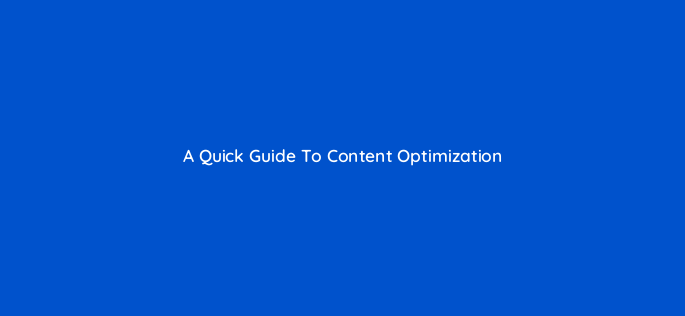Advertisement
You’ve probably heard the saying, ‘content is king’ countless times. And this holds true, especially in the highly competitive digital marketing realm.
But crafting high-quality content is only one of the facets of online advertising. Your efforts to produce stellar digital resources will amount to nothing without content optimization.
This guide will walk you through the basics of content optimization and provide actionable tips on making it happen.

Page Contents
How to Optimize Content
Mobile devices have changed the way people search for product and service information. More than half of consumers, in fact, start their shopping journey with an online search. Due to this change, it’s now de rigueur for businesses to optimize their content for mobile devices.
Optimization means having your content noticed by both machines and humans. But how do you do this?
Below are tips for content optimization success:
-
Conducting Regular SEO Audits
Search engine optimization (SEO) is one of the pillars for boosting content reach and measuring effectiveness. Fortunately, audit tools such as Surfer SEO alternatives can make it easier to find areas on your site that need improvement.
Audit tools can help enhance your content’s visibility. And the stats prove this – SEO drives more than 1000% of traffic compared to social media.
SEO audits can spot technical weaknesses in your page that stymie search engines’ understanding of your content and spoil user experience. Some of these weaknesses that should be avoided like the proverbial plague are:
- Slow loading times
- Erratic page structure
- Broken links
- Meta tags mismatch
Getting rid of these weaknesses can make your website better and more user-friendly.
-
Understanding Search Intent
Creating content without a specific purpose is one of the most serious pitfalls businesses should avoid. By understanding your target consumers’ pain points and preferences, you can create content that resonates with them. Search engines use a site’s relevance, usability, and authority for ranking pages. If your content fails to tick these boxes, your page and content will probably be relegated to the so-called search engine “graveyard,” which is page two of search results.
To have a good chance of appearing on page one, study user intents to get insights. Knowing what your visitors want can help you identify which content format, type, and angle to use. It’ll also help you figure out where your customers are in the buying process.
This knowledge is invaluable, especially if you want to create content that targets buyers at various stages in the buying process.
Try diversifying your content in the form of infographics or gamification elements. These content marketing methods help you generate relevant search intent data you can use to boost your SEO.
You can also understand search intent better with testimonial SEO because customer feedback always matters. Post customer testimonials with keywords applicable to your business. These can be product or service-specific. Such content aligns with what online users love to read about when checking brand information online.
-
Identifying the Right Keywords And Topics
You can use keyword research tools to create content relevant to your base. Remember when content creators did a ton of research and a lot of guessing to come up with the right keywords and search phrases for their niche? With these tools, you won’t have to.
There’s a caveat, though. Targeting high-competition keywords can be difficult and can backfire. A good tactic to consider is to target keywords with high search volumes and low competition instead.
If you target low-competition, high-search volume keywords, your landing pages have a greater chance of ranking high in search engine results pages. Just make sure you can creatively use the keywords in your published content. This step is crucial in ensuring an excellent user experience while satisfying SEO algorithms.
Using the right keywords can be the difference between forgettable and shareable content. Check out web analytics tools to help you identify the most searched and discussed topics to include in your content calendar.
-
Competitor Research
You don’t have to start from scratch when creating a blog or any other content. Consider performing competitor analysis to understand why other businesses rank highly on search engines. Take a close look at the best-performing pages out there and analyze their content—the format they use, structure, topics, and others. Learn from them and you’ll eventually rank high in your niche.
But make sure your content is better. Or at least offers a fresh perspective when tackling a popular subject. Keep in mind, also, that you can repurpose your own content. It’s actually a common optimization practice. You can create a blog from a podcast or video content and vice versa.
-
Adding Internal and External Links
Another method worthy of consideration is backlinking. Backlinking done right helps boost organic traffic. Internal linking, for instance, allows bots to crawl your pages more efficiently. It also improves user experience by making your site easier to navigate.
To optimize your content through linking, choose the right high-authority sites to link to. Find internal pages related to the content and link to them naturally.
-
Improving Your Content’s Structure
Besides relying on technical SEO to improve site and page structure, try looking at your content structure to enhance readability and engagement. Use a template and stick to a brand voice that suits your audience.
Ensure readers always look forward to consuming your content by avoiding long blocks of text. Using bullet points and subheadings and presenting valuable and relevant information in more digestible sections are also good. Eliminating spelling and grammatical errors and writing in an engaging tone helps build authority.
Besides, content without these errors enhances users’ perception of your brand.
More importantly, use relevant images and videos, especially when writing long-form content like white papers, case studies, and e-books. You can also boost them by adding SEO-friendly descriptions and tags but be careful about keyword stuffing.
-
Create CTAs That Convert
Master creating compelling call-to-action pieces if you’re optimizing content for conversion. Use persuasive words in your copy. It also wouldn’t hurt to offer promos like free trials and discounts. Appealing to consumers’ emotions, presenting social proof, and learning how to place CTAs within the content can also work.
In addition, you can also boost your CTA conversion efforts by placing them in strategic areas of your landing pages. Embed them with creative buttons to quickly catch your target audience’s attention. For instance, you can use a yellow or orange button to draw retailers’ gazes to a new product with a corresponding discount.
For the best results, make the design intuitive. The more gauche the presentation, the less likely both long-time customers and newcomers will care.
Wrapping Up
Content optimization is essential for businesses that want to boost visibility, rankings, traffic, audience engagement, conversions, and sales. This process requires understanding how different marketing channels work, what your consumers want, and giving it to them.
If you’re ready to optimize your content, apply the tips mentioned in this blog.
Subscribe to our mailing list and get interesting stuff and updates to your email inbox.
